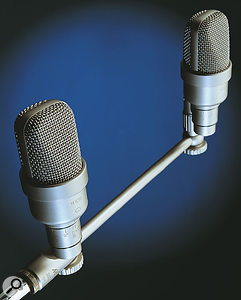I record brass bands regularly using a stereo mic setup (X/Y or spaced pair). The people I record for are always happy with the results, but I feel I can do better. The sound still doesn't come close enough to a commercial brass band recording. My current setup consists of two AKG C1000s mics, a Behringer 1804 mixer and compressor, and a Sony Minidisc. I know that some parts of my setup are not state-of-the-art, but I'm sure the results can still be better. Which mic placement should give the best results? How can I find out if I'm suffering from phase problems? I only use very subtle compression to cut off some peaks. At normal levels the compressor doesn't have to work at all. What could I do to make the sound more bright? Would better preamps contribute to a better-sounding record? The Microtech Gefell M930's ORTF mounting bar allows precise mic placement.
The Microtech Gefell M930's ORTF mounting bar allows precise mic placement.
Ief Sels
Technical Editor Hugh Robjohns replies: The first thing I'd say is that the C1000s doesn't have a particularly good high-frequency response. Brass instruments have a very strong harmonic content which is critical to their sound, so I fear that your mics are not ideal for the task. The other thing to mention straightaway is that the Minidisc format uses a data reduction system which discards a lot of subtle information, and this will affect the perceived quality of your recordings as well.
In terms of mic placement, coincident and spaced mic arrays produce different kinds of stereo imaging. Choose the configuration that you feel sounds best in each location. Personally, given a pair of cardioid mics I'd probably start with an ORTF arrangement (named after the French broadcasting network, Office de Radiodiffusion Television Francaise), which largely combines the best of both coincident and spaced configurations. Angle the mics outwards at 110 degrees to each other (in other words, 55 degrees each side of the centre axis), and space apart by about 17cm (see diagram). It depends on the room to a degree, but I find this arrangement usually gives good imaging with a nice sense of spaciousness.
You'll always risk encountering phase problems using spaced microphones, since the two mics capture sound from a given source at different times, and hence with different phases. However, I've never had a problem of this kind with the ORTF configuration, although whether or not you'll suffer phase problems in a specific venue is hard to predict. To find out, simply listen in mono. If the mono sound is noticeably coloured compared to the stereo sound then you have phase problems and the only practical solution is to revert to a coincident (X/Y) mic arrangement. Coincident mics don't suffer phase problems at all since the two mics capture sounds from any direction at exactly the same time (and hence phase).
 Finally, I wouldn't record with a compressor at all. Most compressors reduce brightness of the material when driven and that's the last thing you need here. It sounds like you are only using the compressor as a security blanket anyway, so instead, why not simply leave a few more decibels of headroom in your recording. That way you won't have to worry about peak overloads while recording, and you can adjust the overall dynamic range and levels as a post-production treatment, when you know exactly what you have to play with, and can make such critical decisions without committing them forever to the original recording.
Finally, I wouldn't record with a compressor at all. Most compressors reduce brightness of the material when driven and that's the last thing you need here. It sounds like you are only using the compressor as a security blanket anyway, so instead, why not simply leave a few more decibels of headroom in your recording. That way you won't have to worry about peak overloads while recording, and you can adjust the overall dynamic range and levels as a post-production treatment, when you know exactly what you have to play with, and can make such critical decisions without committing them forever to the original recording.
To answer your last question, yes, better preamps will contribute to a better-sounding recording, but it's a case of degree. Using more appropriate mics and recording with an uncompressed format will probably have a more significant effect on the quality of your recordings and I would suggest that that should be your first approach. Almost any of the small-diaphragm condenser mics on the market would probably give you better results. I'd suggest the Rode NT5s or Sennheiser e664 (superb value for money but soon to be discontinued), or maybe the SE Electronic SE1s if your budget is tight. After that, maybe think about changing the recorder for something with better converters, decent preamps and a linear recording format. The new Fostex FR2 would be an excellent (if still relatively expensive) choice for a hardware recorder, or you could think about using a USB or Firewire interface box and recording directly to a laptop computer.
